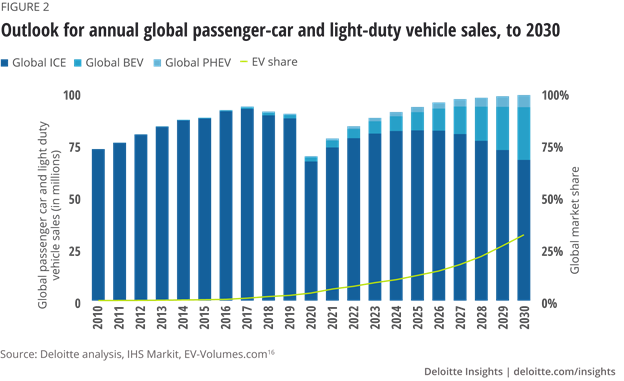By Kumar Abhimanyu, SVP, Mobility Sales and Adam Emfield, Director, User Experience and the Cerence DRIVE Lab

It’s often been said that history repeats itself – and our habits at the pump are no exception. Evidence suggests that the fuel dispensing industry has had a close correspondence to disruption patterns. The electric vehicle (EV) movement, and the charging infrastructure around it, is the latest and brings with it a completely new way to look at consumer engagement.
From Ford and GM to VW and Mercedes-Benz, the world’s OEMs, both large and small, are going electric, committing to eliminating production of internal combustion engine (ICE) vehicles by 2035. This large-scale electrification of vehicles will create the biggest shift the automotive industry – and those supporting it – has experienced in more than a century.

Source: Electric vehicle trends | Deloitte Insights
The EV Consumer Journey
While much attention is paid to what this change will mean for charging infrastructure and emission rates, it’s critical to also recognize the immense shift the move to EVs will have on consumer behaviors. Taking three minutes to fuel up at the pump and popping in for a coffee in the convenience store – an industry of approximately $500B – will be a thing of the past. Charging will become as fundamental to driving as navigation, where consumers will top-up charge everywhere from the local coffee shop to the mall. Customers will be able to subscribe for energy instead of paying as they go. And innovation in this space won’t be limited to Chargepoint and Blink and Tesla. It will bring with it new ways to advertise, interact, and engage.

Largely due to the way batteries are built, EV charging can take anywhere from a few minutes for a top off to several hours for a full charge. Consumers will approach it much differently than how we get gas today. Entire customer journeys will be shaped around where and when people can get a charge, and the time it takes to do so. As people travel, they will consider the role their EVs play in the larger mobility ecosystem, parking where they can charge before hopping on a train or walking into the city center. We will see the industry standardize on infrastructure – meaning any electric vehicle will be able to charge up at any station – and that in turn will make charging ubiquitous in our everyday lives.
Capitalizing on the EV Evolution with Voice

This massive shift in consumer behavior, where day-to-day buying decisions are driven by charging needs, will make the car a powerful place for commerce. Brands will be able to capture drivers’ attention and wallets while they are charging and draw consumers to their brick-and-mortar locations by offering on-site charging options. Voice-assisted, location-based navigation systems within the car, connected smart EV Charging Stations with screens and companion mobile apps will be central to this new EV charging commerce ecosystem because they can facilitate proactive, seamless, and secure interactions as part of the experience drivers already know and trust. It makes the interaction dynamic, engaging, interactive, and a much more fulfilling experience.
An in-car assistant could identify the EV is low on charge and proactively serve the driver directions to nearby charging sites as they plan out their day, with tips on coffee and food options that will keep them charged and make range anxiety a thing of the past. That same assistant could not only identify how much charge the car needs and the driver’s usual coffee choice but also offer to pre-order and pre-pay for both using voice biometrics authentication. If the driver doesn’t want to leave the car while charging, the voice assistant can keep them engaged with entertainment options like in-car karaoke, teach them about a nearby landmark, or even allow them to collect an NFT only available at this location.
The nature of charging will make the car central to a driver’s buying decisions, and because voice assistants integrate on-board data with cloud applications, they can connect drivers to local and timely discounts related to their charging plans. Consider a driver stopping at a mall to charge. The voice assistant knows from previous trips the driver likes Thai food and can proactively ask if they want to get lunch at a Thai restaurant while they charge up, serving up a discount code only available at that date and time.
Because of this dynamic and the changes in consumer behavior EV charging will bring with it, we see the car exponentially growing in its ability to serve as a revenue generator both for OEMs and brands. Instead of adding another layer of complexity, voice engagement helps EVs reach their potential by streamlining the charging experience into the overall driving experience, making it easy for drivers to make the most of their experiences in and out of the car.
The EV future is coming. And voice-enabled applications will be critical in giving drivers the familiar connection they need to a world around them that may feel brand new.
